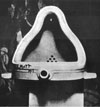The Dada Movement

In 1920, many artists in Western Europe harboured a deep contempt for materialist bourgeois society and its arrogant faith in science and technology, a society which, since the First World War, the Dada movement had aimed to disturb with their provocative works. In 1920, however, new means of expression were being developed, and non-European objects had become increasingly common. More than 30 years prior to this, Gauguin had turned towards traditional Oceanian cultures to find the necessary resources for the new means of expression that he wanted to develop, starting by acquiring two Minkissi statuettes from the Congo, which he displayed at the Exposition Universelle de Paris in 1889. A little later, in the 1900s, Picasso became inspired by traditional Congolese art, particularly for his Demoiselles d'Avignon (1907). Unlike Western tradition, the so-called "primitive" artists attempted neither to reproduce nature, nor ideal beauty, offering an alternative to the Western tradition that was in crisis and new opportunities that were so sought after by the avant-garde artists.
Such artists, for whom the meaning of words was too narrow and rigid, sought, rather simply reinventing existing codes once again, to transcend the categorisation of the real, advocating the submission of the unknown to the known, taking interest in the opposition between dreams and reality. The Surrealists participated in this battle. André Breton, who founded the movement in 1924 with his Manifeste du surréalisme, saw the works of Freud as a rediscovery of the resources of the imagination and dreams, masked by the obsessive rationalisation of the world. He used the theory of unconsciousness to develop the artistic method that he called Surrealism or the search for the resolution of the opposites, dream and reality, by creating a surreality. Automatic writing, or writing in a stream of consciousness, is an important part of this method: reflection, and therefore reason and rereading, put aside, it is about allowing "the phrases alien to our conscious thoughts that want to be externalised" to emerge (Manifeste du surréalisme).
The place of Non-European objects in the Surrealist movement is not always an obvious one. Enigmatic objects inspired the majority of these artists and poets, with the well-known exception of René Magritte. A far cry from the Western arts, non-European objects represented a diversity characteristic of the universalising aim of the Surrealists. Moreover, the relationship between the Surrealists and Tribal art also offers the contemporary audience an interesting entry point by which to discover the often under-appreciated Indigenous arts, with one such opportunity taking place from 9 May 2015, at the Galerie Flak, in Paris, in the form of an exhibition of works from Africa, Oceania, and North America, entitled "Objets Surréalistes". [...]
Art Media Agency / May 7, 2015
Dada was born tomorrow
All over the world, discoveries have been made under the dadaists' inspiration: whether they were the domestication of the photographic "art" in Berlin through Hausmann and Heartfield's photomontages, or Man Ray's "Rayograms" in America; the upsetting of the process of retinal knowledge by Duchamp's "optical machines" or Picabia's "transparencies", heralds of op art; or again the use of collaborative works (Fatagaga in Cologne or Cadavres exquis in Paris) as a substitute for the cult of personality, far too prevalent among painters and gallery owners; and the appropriation as "art" of ordinary objects (Duchamp, Picabia, Man Ray ou Schamberg).
Thus we could follow at length Dada's encroachments on the various frontiers of the human imagination. And it is doubtless this polyvalence which explains the actual reawakening of interest among artists belonging to opposite tendencies. Its is also why the dadaist aventure is so close to the sensitivity of the 20th and the budding 21st century, which has been dominated by a need for systematic revolt against existing forms, in politics, in literature and in the arts: against all form, because it is form, and therefore limitation.
It can be seen that Dada's greatest lesson, tacitly transmitted to its successors, is not an esthetic, but a philosophical one: on the best use of revolt. It is by unceasingly, patiently, obstinately putting into question the most well established truths, that man will become conscious of his collective destiny: "I revolt, therefore we are", will say Camus. Unexpectedly and unwillingly, Dada saw new esthetic concepts blossoming out of its nihilism, thereby learning at its own expense that if art is difficult, it is even more difficult for man not to create.